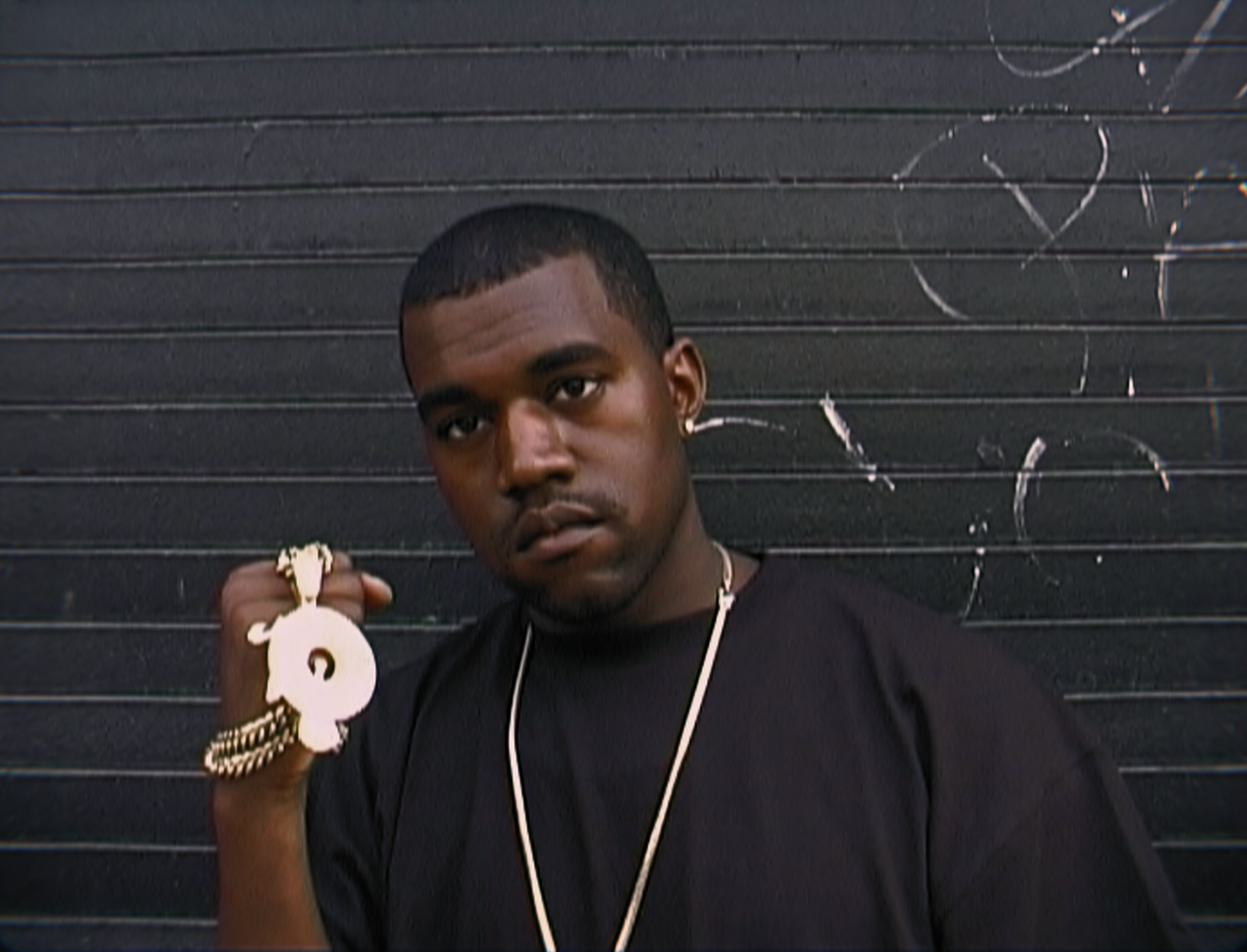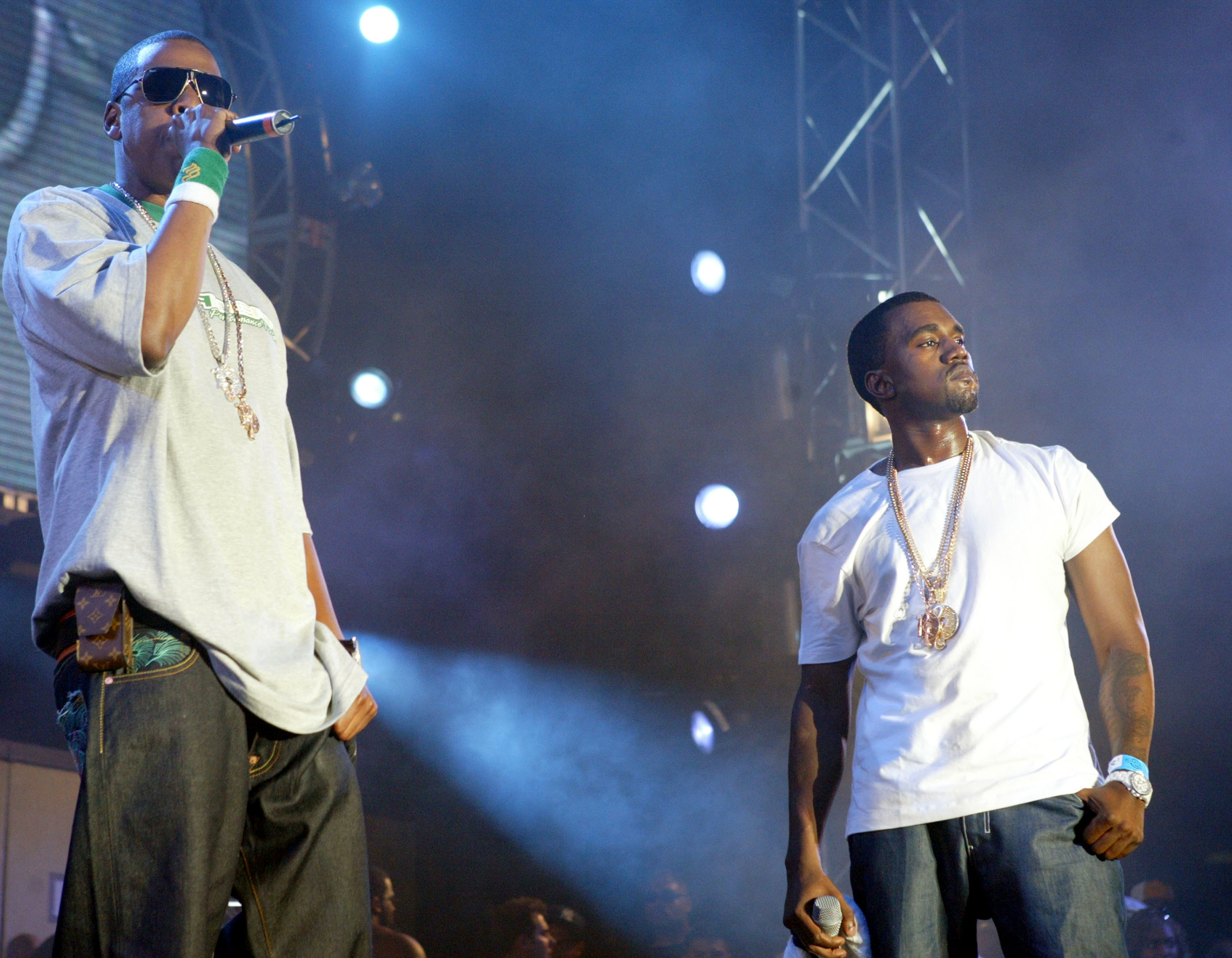
Kanye West is waiting for his turn. He stands back quietly, watching from the sidelines. It’s August 2002 and the producer is in his hometown of Chicago for Jay-Z’s Dynasty Tour. Backstage, he shyly introduces himself to Pharrell. Beyoncé smiles politely. He’s garnered some minor traction, mostly producing tracks for Jay-Z, but his name is far from ubiquitous. He has the kind of anonymity that seems hard to imagine now, especially for someone who just legally changed his name to “Ye.” But not for long. “Kanye. Got some big news. You want to tell them?”asks Jay-Z, inviting him to the stage.
Jeen-Yuhs: A Kanye Trilogy follows Kanye’s trajectory from outsider to hip-hop heavyweight. The first episode of the three-part series, which includes the sequence of him backstage, spotlights him grinding in the periphery. (Jeen-Yuhs is produced by TIME Studios, the film and television division of TIME.) The pivot from producer to rapper is fraught with apprehension. There were skeptics: After all, making a beat doesn’t exactly mean he could spit a hot 16 bars on a song. How would his content about dropping out of college and Louis Vuitton backpacks fit within rap’s typical machismo? And despite its talent pool, Chicago was an overlooked zip code in hip-hop and many of its rappers languished as nothing more than regional heroes. But as the film makes abundantly clear, Kanye always believed in himself. The episode ends in a crescendo, when he announces that he’s signed to Roc-A-Fella Records, hallowed ground of millennium-era Jay-Z, Cam’ron, and State Property. Label co-founder Dame Dash takes off his chain—studded with canary yellow diamonds—and puts it on the ascendant’s neck with flourish. “I’m the newest member of the Roc-A-Fella team,” Kanye raps gleefully, anointed.
The Roc-A-Fella chain is one of hip-hop’s most iconic symbols. The chain—which features the logo of a vinyl record with a bottle of champagne and a cursive “R” (designed by the late Adrian Vargas)—originated with Dash, who curated an aspirational lifestyle (which later included Rocawear clothing and Armadale Vodka) with co-founders Jay-Z and Kareem “Biggs” Burke. “I just wanted to create a chain that represented who we are,” says Dash. Minted with hustler’s DNA in 1995, the company’s ethos was entrepreneurship. They famously invested their own capital and sweat equity so that they could be their own bosses. “When three young Black men out of the projects suddenly had the world at our fingertips, it was hard to convince us that anything wasn’t possible. I guess that included opulence,” says Burke. “Dame and I are from Harlem, where luxury is a state of mind. Jay just so happens to have the talent to paint that picture in his music.” Rapper Tone Hooker came up with the label’s moniker as a double entendre for success—echoing magnate John D. Rockefeller and a rapper dominating his opponent (“rocking a fella”). They wanted to be first in class; in music, visuals, marketing. “It symbolizes Black excellence,” says Hooker.

Dash doesn’t remember exactly when he started having chains made—Hooker thinks around 1996 and Burke remembers 1997 or 1998— but he designed them mostly with Jacob Arabo a.k.a. Jacob the Jeweler. “It’s a reflection of how much wealth you have,” says Dash. And for someone like West who hadn’t made it yet, “jewelry can make it look like you have a lot more than you do.” According to former Roc-A-Fella employees and close associates, getting the original chain required approval from at least two out of the three founders. It wasn’t something you could (or should) ask for. “I’m the only person who ever gave Roc-A-Fella artists a chain,” says Dash. “If you notice, I took the chain off my neck to give that to Kanye. I was supposed to get that back, but I never got that back,” he says with a laugh. Outside of the label’s roster, select colleagues and friends (like those coming home from incarceration) could be blessed, any time. “They just huddled up and say, ‘Yo, you think this person gets a chain?’ and then surprise, you can get a chain!,” says Hooker.
The circumstances around acquiring a chain has become the stuff of rap lore: Dash gave chains to artists to coincide with album releases. “But like for Kanye, I just wanted to empower him. And that’s why I gave him the chain in front of everyone in his hometown,” he says. Freeway fondly remembers being inspired when Memphis Bleek and Beanie Sigel got theirs at upscale eatery Mr. Chow. “I’m like, I gotta be next up to get it! So that made me want to work harder.” He got his chain before his debut album Philadelphia Freeway came out in 2003. Hooker got his only last year, with a nice note from Jay-Z. Jeweler Ben Baller tried on his first chain—in rose gold, designed by Chris Aire— on the set of Jay-Z’s “Song Cry” in 2001. “At that point, I’d never seen rose gold before,” says Baller, who now has several chains. “From my knowledge, Dame was the first person to wear rose gold. It also had black diamonds. Really rare with a unique link.”
The chain came with fringe benefits, too. In the early aughts, Baller helped West, who he didn’t know then, get into a Los Angeles hot spot because he had the right jewelry. “So he’s trying to get into the club. He doesn’t have enough juice to get into LAX [but] he’s wearing a Roc chain,” says Baller. “I’m like, look, we gotta get this dude in the club.”

In 2004, Jay-Z, Dash and Burke sold Roc-A-Fella Records for a reported $10 million. Their continued successes, individually and Jay-Z’s subsequent Roc Nation ventures, have kept the brand—and chain—alive. The Roc-A-Fella chain is constantly name-checked: Kanye’s “Diamonds” (“I’m talking bout Rocafella, my home, my chain”); Jay-Z’s “Public Service Announcement” (“Got the hottest chick in the game wearing my chain”); and Beyoncé’s “Formation” (“I’m so possessive so I rock his Roc necklaces”). It’s no wonder that it outlasted hip-hop ephemera of the same time—the pendants of Death Row, No Limit, or Cash Money Records. Originals from the days before the sale are still floating around. And then there’s the rip-offs.
The new iteration of the Roc-A-Fella chain (affiliated with Roc Nation) is mostly designed by Ben Baller, who explains that the standard begins at $50,000, but quickly rises into the six figures with various colorways in gold and a high quality of VVS2 diamonds. Even if money is no object, it’s a strict velvet rope. The jeweler reveals that someone asks him at least weekly to make a chain. No dice. The entry process is a black box. “The only thing I can say that’s true, is that the rules have changed, and I don’t think any of the chairmen should be talking about what the process is,” says Burke.
The chain’s cache continues with younger generations. Lil Uzi Vert got his. So did J. Cole, Big Sean, and DJ Khaled. “The Roc chain represents an era in hip hop where quality meant more than quantity. The artists that do their homework respect that,” says Burke. Meek Mill was chained in 2018 and recently described it as bigger than receiving a Grammy. “There’s the Grammys. There’s the Tonys. There’s the Oscars. And then there’s the Roc-A-Fella chain,” SAINt JHN explains. He received an original Roc chain from Burke, who is his manager, before he got on a plane to care for his mother during the pandemic, underscoring how brotherhood is gilded into the piece. “He didn’t want to wait for the perfect occasion. It just felt right.” There’s a line of people waiting their turn. “I’m auditioning for my Roc-A-Fella chain,” says Benny The Butcher, who signed to Roc Nation in 2019. “You don’t ask for that…but I’m just throwing hints.”
The Roc-A-Fella chain is the American Dream—on display for everyone to see. “It meant I was a part of the dynasty. I was a part of history,” says Freeway. It’s a crowning glory, social proof, a totem of fraternity. “It’s not a chain, it’s a symbol,” says SAINt JHN. “It’s a symbol of all the guys that made it out. It’s a symbol of all the guys that kept their integrity intact.” And when Kanye West wore his chain, it was the coronation of hip-hop’s next superstar.
jeen-yuhs premieres on Netflix beginning Feb. 16. Twenty-four years in the making, this documentary about Kanye West was directed by Coodie & Chike, from TIME Studios and Creative Control.
More Must-Reads From TIME
- The 100 Most Influential People of 2024
- The Revolution of Yulia Navalnaya
- 6 Compliments That Land Every Time
- What's the Deal With the Bitcoin Halving?
- If You're Dating Right Now , You're Brave: Column
- The AI That Could Heal a Divided Internet
- Fallout Is a Brilliant Model for the Future of Video Game Adaptations
- Want Weekly Recs on What to Watch, Read, and More? Sign Up for Worth Your Time
Contact us at letters@time.com